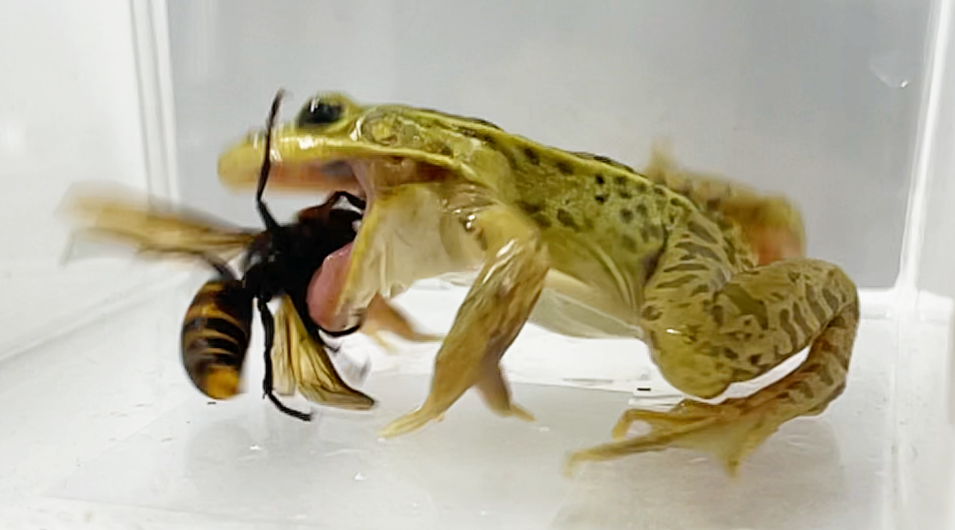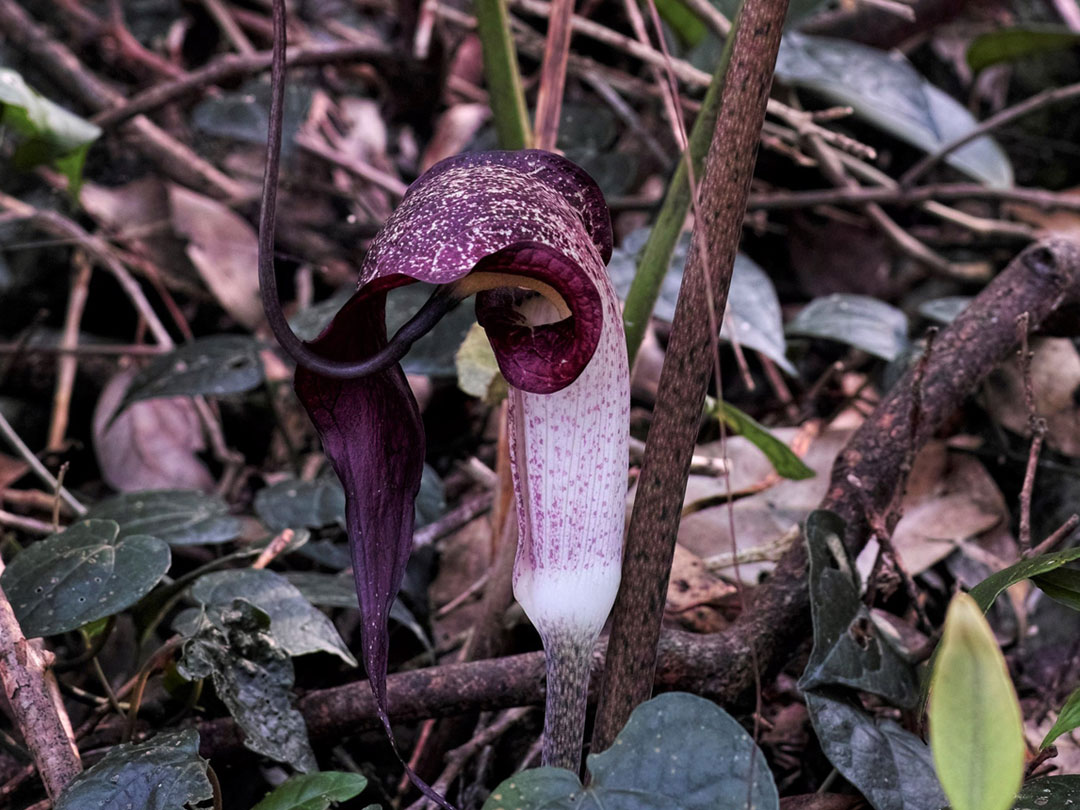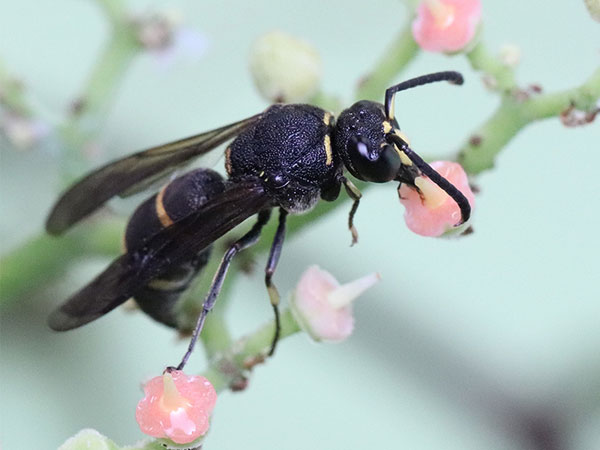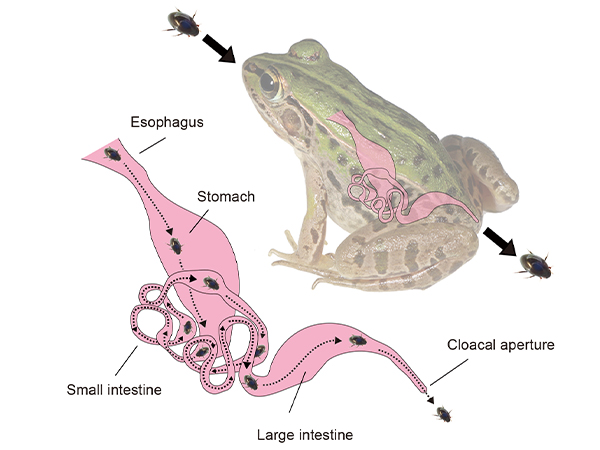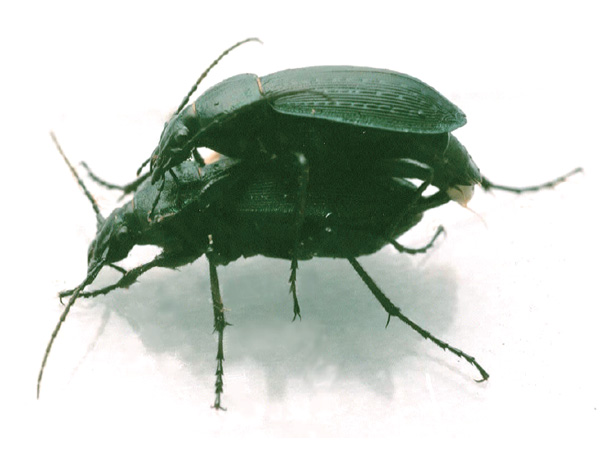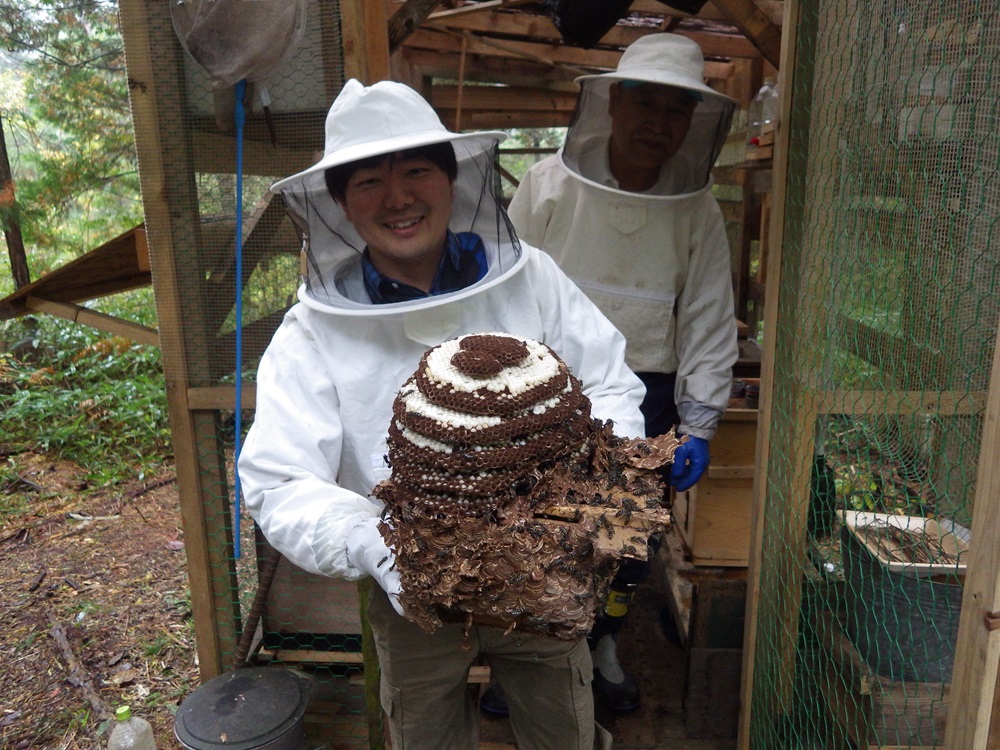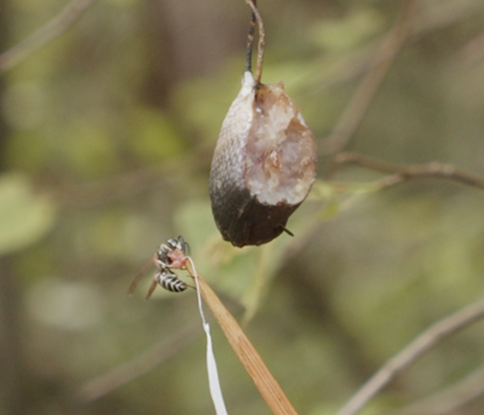Associate Professor SUGIURA Shinji’s discovery that a species of beetle can survive being eaten by a frog by escaping via its cloacal aperture has received much attention and has been widely covered by international media. The insect in question is Regimbartia attenuata, a small aquatic beetle often found in paddy fields on Japan’s main island and in the south of the country.
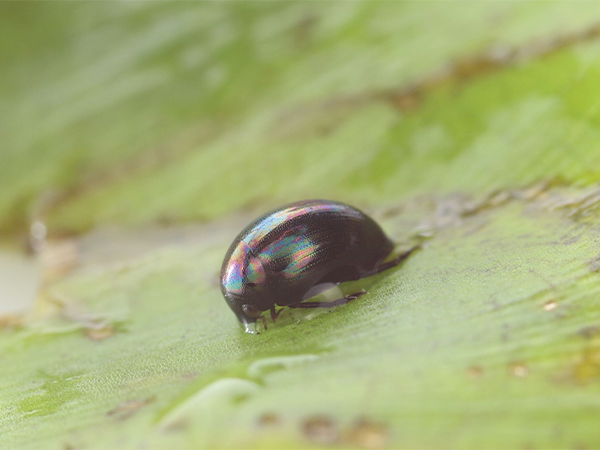
R. attenuata is a small aquatic beetle that is between 3.8mm to 5.0mm in length. Adults eat aquatic plants in habitats such as paddy fields. They normally swim under the water and sometimes fly above the water’s surface.
Professor Sugiura’s research is not just limited to this beetle; he has been investigating the interactions between various insects and other living things (such as plants) from an ecological viewpoint. He describes this research on R.attenuata as the ‘discovery of an amusing aspect of insect ecology’, however investigating interspecific interactions, such as those between predator and prey, is also important for the conservation of threatened ecosystems.
In addition, research into the forms and functions of plants and animals is presenting increasing possibilities for biomimetics, in which structures and properties found in nature are applied to the creation of new products that contribute to society. We asked Professor Sugiura about the hidden potential of some kinds of research on insects.
Researching insect defense mechanisms
What kind of discipline is ecology?
Associate Professor SUGIURA:
It is generally defined as research into the interactions between organisms and their environment. I am dealing with the interactions between various species and between individuals of the same species.
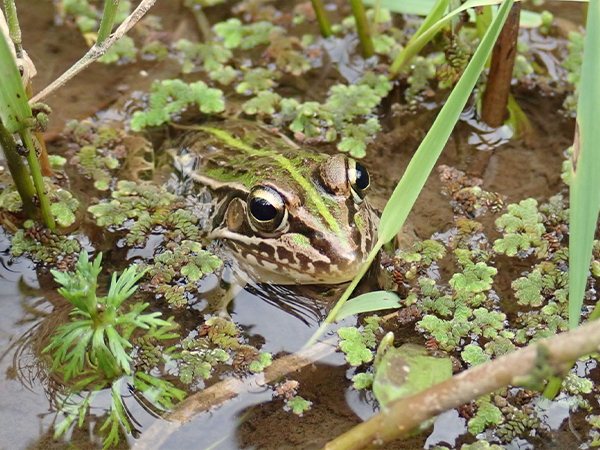
What is the difference between biology and ecology?
Associate Professor SUGIURA:
Ecology is a branch of biology. I think that most fields of biology involve conducting research on a cellular level and below, for example DNA, however ecology mainly deals with matters on an individual level and above.
Of course, ecology also involves studying DNA but it covers an extremely broad range of areas including research into environmental aspects like carbon and nitrogen cycles. My research fields are community ecology, species interactions and behavioral ecology. My research often involves insects, so you could also say that my field is insect ecology.
What is the significance of researching and teaching ecology at the Graduate School of Agricultural Science?
Associate Professor SUGIURA:
I am a member of the Laboratory of Insect Biodiversity and Ecosystems. The study of insects has always been conducted as part of the field of agriculture because research into controlling pests has been important for agricultural industries. Consequently, entomology began under the umbrella of agricultural studies and this is why I conduct ecology research using insects.
What does researching insect biodiversity and ecology involve?
Associate Professor SUGIURA:
First of all, it involves taxonomy; describing a new species that does not have a scientific name yet. Secondly, it involves biodiversity studies, which includes defining how diverse insects are. Thirdly, it also involves ecology, which consists of describing insect life histories and behaviors. For example, this includes identifying pest insects and natural enemies in a specific area and investigating the structure of insect communities, or which insect species function as pollinators of flowering plants.
One of the likely reasons that pest populations are increasing is that their natural enemies do not often eat them. Why is this the case? I am interested in how insects defend themselves against their natural enemies, so I conduct research into their defense mechanisms.
Are all these research topics related to agriculture?
Associate Professor SUGIURA:
This has always been the case. Actually, some students are moving away from the agricultural angle and conduct research purely on insect ecology. My research on R. attenuata is a result of this movement. I hope that this story entertains ordinary people (laughs).
How R. attenuata escape from frogs

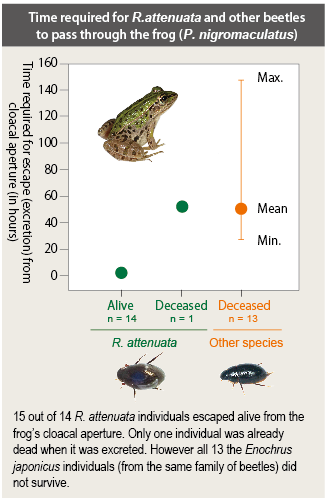
Have you been researching the ecology of R. attenuata for a long time?
Associate Professor SUGIURA:
No, this discovery happened by chance. Some years ago, I began studying the defensive behaviors of various insect species that live in farmland areas. Up until now, I have provided frogs with over 50 insect species to investigate their defenses against frogs. I place a frog and an insect in a plastic case and observe their interaction. Frogs can catch insects with their tongues in the blink of an eye. In order to investigate what kind of defense mechanism the insect used, and to confirm whether it was eaten or managed to escape, I film this interaction and then play it back in slow motion.
According to your research, it takes an average of 1.6 hours for R. attenuata to escape after being eaten by a frog. Did you keep filming with the expectation that insects would escape?
Associate Professor SUGIURA:
Around 2 years ago, I discovered that another species of insect could escape by making the frog regurgitate it less than an hour after being eaten. This insect is known as the bombardier beetle (Pheropsophus jessoensis). It secretes a hot chemical substance from its behind, a bit like a fart, which makes the frog feel unwell and vomit. From this earlier discovery, I predicted that R. attenuata may also try to escape from the frog’s body after being eaten.
So you continued filming the frog and then discovered that the beetle had escaped about an hour or so later, right?
Associate Professor SUGIURA:
I did not film the escape the first time it happened. When I checked on the frog about an hour and a half after it had eaten the beetle, I noticed that the beetle was in the case too. I always check the frog’s mouths after they have eaten to see if the insect has been swallowed. I was certain that the frog had eaten this insect so I realized that it may have escaped from the frog. At that point, I didn’t know whether it had escaped by being regurgitated, like the bombardier beetle, or if it had escaped via the frog’s behind (i.e. through the cloacal aperture). Subsequently, I was able to capture the beetle’s escape on video and could confirm that it came out of the frog’s behind.
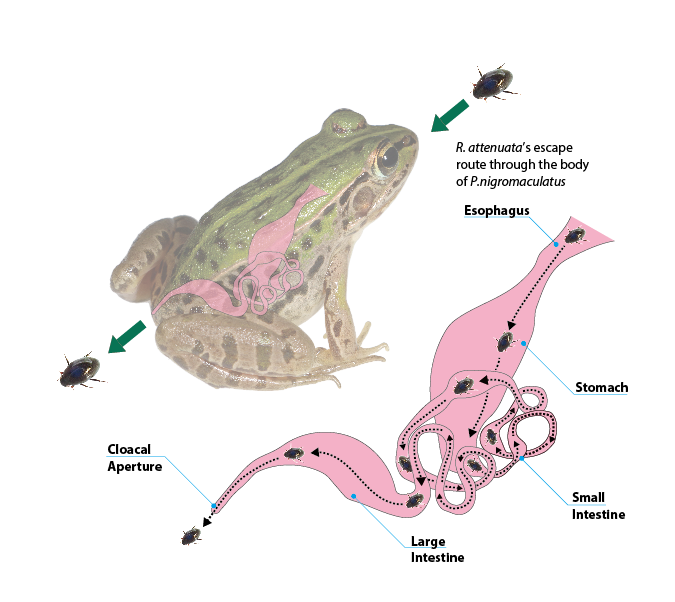
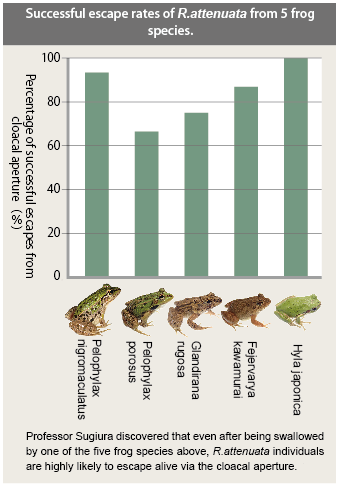
Is it rare for a creature to be able to escape via the predator’s behind?
Yes, it is. Although there are some species that are known to do this, they are usually expelled at the same time as the excrement.
Normally, consumed insects are expelled from the frog’s body as excrement 1 to 2 days after being eaten. R. attenuata is able to escape alive after a period of time ranging from a few minutes to six hours at the longest, without having to wait for the frog to excrete it. I think that it does this either by actively trying to escape or by stimulating the frog’s gut to promote excretion. I believe that this is the first time that such a quick, active escape of prey from the body of a predator has been documented.
Do you have any plans to research how the beetle promotes its excretion?
I have conducted experiments where the frog was given an R. attenuata that cannot move its legs. The beetles were unable to escape from the predator’s body in these cases. I am not yet sure exactly how R.attenuata escapes but I believe that it uses its legs and movement to promote excretion rather than producing a chemical substance. For example, people use suppositories as a laxative. Suppositories work by causing gas to build up when they are inserted into the rectum, which in turn puts pressure on the digestive tract and promotes excretion. I think the movements of R.attenuata might have a similar effect, as in they put pressure on the frog’s digestive tract which promotes excretion. However, I recorded video footage of an R.attenuata crawling out of the cloacal aperture, so it is not completely impossible that the beetle is able to escape using its own strength. Also, R. attenuata has a tough, streamlined body, which may provide protection against the frog’s digestive juices and aid its escape from the cloacal aperture.
How can you investigate the beetle’s actions inside the frog’s body?
There are some species of frog found overseas that have translucent skin. You can see the frogs’ internal organs from the outside, therefore if I fed R.attenuata to these species it may be possible to observe the beetles’ movements inside the frogs. In addition, a modified translucent frog has been developed in Japan. I hope that I can use these frogs in my experiments.
Insect research and its contribution to society
You have conducted research on a wide range of insects and plants. Is there a research topic that you are particularly intent on pursuing?
For the moment, I would like to focus on researching insect defense mechanisms. I hope to examine the issue as to why certain pest species are increasing in number by elucidating their defensive behaviors against natural enemies.
Beyond that, I think it would be good if my research could contribute to society in an interesting way. Rather than contributing directly via my own research, I would be happy if another researcher or research group could apply my results to their own work. For example, research on insects could be useful for the biomimetics field, in which researchers engineer new products or devices by imitating nature, such as the structures, functions and forms of organisms. Research on insects could be utilized in such a field.
So your research results could be applied to the creation of robotics technology, for example?
That is also a possibility but let me give you another example. There is a species of beetle that lives in the desert. On misty mornings, this beetle is able to trap water from the air on the surface of its body and consume these droplets of moisture. The surface structure of this insect has been illuminated, and products such as sheets and bottles that can accumulate water even in a desert environment are being developed by physically recreating the surface structure.
Although this is not related to insects, geckos are able to climb slippery walls because the van der Waals force (i.e. the attraction between molecules) generated by the fine hairs on the soles of its feet enables it to stick to the surface. A new type of adhesive tape was actually developed by mimicking the hairs on the gecko’s feet.
Your research is a treasure trove of possibilities for biomimetics?
I am not able to come up with designs for these products myself as I do not have the engineering knowledge, however I hope my research can be used to create something useful for people.
In terms of social contribution, research into interactions between living things may be beneficial for the conservation of natural ecosystems. That is to say, if we can establish what kind of interactions exist between organisms; we can understand whether environmental factors will have a strong impact on the ecosystem. For example, some natural forests are able to protect themselves from invasive species. Even if an invasive insect species manages to enter the forest, there are animals that will consume it and the highly competitive native trees exclude invasive plant species.
In other words, the competition between organisms and the relationships between predators and prey are intertwined in such a complex way that species from outside are not able to participate. In addition to this, such rich forests also help to minimize the impact of species proliferation and extinction. Species interactions encompass competition and predator-prey relationships among a wide variety of species. By conducting research into these interactions, we can get a sense of the strength of a particular ecosystem and be able to explain it in a logical way.
It is a fascinating area of research. Thank you very much for your time.
Note: this article is also available as a PDF in Vol. 10 of the Kobe University Newsletter "Kaze" (April 2021).
Interviewee Profile:
Associate Professor SUGIURA Shinji (Graduate School of Agricultural Science)
Dr. Sugiura graduated from Kyoto University in 2004. Before taking up his current position at Kobe University in 2013, he was a researcher at the Forestry and Forest Products Research Institute. He has received the 18th Denzaburo Miyadi Award from the Ecological Society of Japan and the Young Scientist Award from the Entomological Society of Japan for his work that has focused on the ecological roles of insects and species interactions. He is interested in insects’ interactions with various other organisms, including plants, birds, mammals, amphibians, fungi and slime molds.






